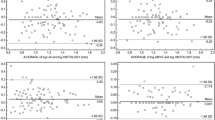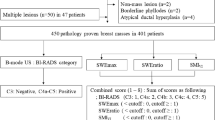Abstract
Purpose
To compare the performance of radiologists in the use of conventional ultrasound (US) and automated breast volume ultrasound (ABVU) for the characterization of benign and malignant solid breast masses based on breast imaging and reporting data system (BI-RADS) criteria.
Materials and methods
Conventional US and ABVU images were obtained in 87 patients with 106 solid breast masses (52 cancers, 54 benign lesions). Three experienced radiologists who were blinded to all examination results independently characterized the lesions and reported a BI-RADS assessment category and a level of suspicion of malignancy. The results were analyzed by calculation of Cohen’s κ coefficient and by receiver operating characteristic (ROC) analysis.
Results
Assessment of the agreement of conventional US and ABVU indicated that the posterior echo feature was the most discordant feature of seven features (κ = 0.371 ± 0.225) and that orientation had the greatest agreement (κ = 0.608 ± 0.210). The final assessment showed substantial agreement (κ = 0.773 ± 0.104). The areas under the ROC curves (Az) for conventional US and ABVU were not statistically significant for each reader, but the mean Az values of conventional US and ABVU by multi-reader multi-case analysis were significantly different (conventional US 0.991, ABVU 0.963; 95 % CI −0.0471 to −0.0097). The means for sensitivity, specificity, positive predictive value, and negative predictive value of conventional US and ABVU did not differ significantly.
Conclusion
There was substantial inter-observer agreement in the final assessment of solid breast masses by conventional US and ABVU. ROC analysis comparing the performance of conventional US and ABVU indicated a marginally significant difference in mean Az, but not in mean sensitivity, specificity, positive predictive value, or negative predictive value.


Similar content being viewed by others
References
Liberman L, Feng TL, Dershaw DD, Morris EA, Abramson AF. US-guided core breast biopsy: use and cost effectiveness. Radiology. 1998;208:717–23.
Mendelson EB, Tobin CE. Critical pathways in using breast US. Radiographics. 1995;15:935–45.
Parker SH, Jobe WE, Dennis MA, Stavros AT, Johnson KK, Yakes WF, et al. US guided automated large-core breast biopsy. Radiology. 1993;187:507–11.
Stavros AT, Thickman D, Rapp CL, Dennis MA, Parker SH, Sisney GA. Solid breast nodules: use of sonography to distinguish between benign and malignant lesions. Radiology. 1995;196:123–34.
Buchberger W, DeKoekkoik-Doll P, Springer P, Obrist P, Dunser M. Incidental findings on sonography of the breast: clinical significance and diagnostic workup. Am J Roentgenol. 1999;173:921–7.
Kopans DB. Breast cancer screening with ultrasonography. Lancet. 1999;354:2096–7.
Berg WA, Blume JD, Cormack JB, Mendelson EB, Lehrer D, Bohm-Velez M, et al. Combined screening with ultrasound and mammography vs mammography alone in women at elevated risk of breast cancer. JAMA. 2008;299:2151–63.
Chou YH, Tiu CM, Chiang HR, et al. Ultrasound BI-RADS categories applied in an automated breast ultrasound system: diagnostic reliability. Radiological Society of North America scientific assembly and annual meeting program. Oak Brook: Radiological Society of North America; 2006.
Destounis S, Young W, Murphy P, et al. Initial experience of automated breast ultrasound screening trial in the setting of a community based private practice. Radiological Society of North America scientific assembly and annual meeting program. Oak Brook: Radiological Society of North America; 2006.
Kelly KM, Dean J, Comulada WS, Lee SJ. Breast cancer detection using automated whole breast ultrasound and mammography in radiographically dense breasts. Eur Radiol. 2010;20:734–42.
Kelly KM, Dean J, Lee SJ, Comulada WS. Breast cancer detection: radiologists’ performance using mammography with and without automated whole-breast ultrasound. Eur Radiol. 2010;20:2334–64.
Landis JR, Koch GG. The measurement of observer agreement for categorical data. Biometrics. 1977;33:159–74.
Metz CE. Some practical issues of experimental design and data analysis in radiological ROC studies. Invest Radiol. 1989;24:234–45.
Metz CE. LABMRMC 1.0B software. Department of Radiology, University of Chicago, Illinois. ftp.minira.bsd.uchicago.edu/roc/.2001(Accessed April 10).
McClish DK. Analyzing a portion of the ROC curve. Med Decis Making. 1989;9:190–5.
Bulpitt CJ. Confidence intervals. Lancet. 1987;1:494–7.
Richter K, Heywang-Köbrunner SH, Winzer KJ, Schmitt KJ, Prihoda H, Frohberg HD, et al. Detection of malignant and benign breast lesions with an automated US system: results in 120 cases. Radiology. 1997;205:823–30.
Kotsianos-Hermle D, Hiltawsky KM, Wirth S, Fischer T, Friese K, Reiser M. Analysis of 107 breast lesions with automated 3D ultrasound and comparison with mammography and manual ultrasound. Eur Radiol. 2009;71:109–15.
Lin X, Wang J, Han F, Fu J, Li A. Analysis of eighty-one cases with breast lesions using automated breast volume scanner and comparison with handheld ultrasound. Eur J Radiol. 2011. http://dx.doi.org/10.1016/j.ejrad.2011.02.038.
Chang JM, Moon WK, Cho N, Park JS, Kim SJ. Radiologists’ performance in the detection of benign and malignant masses with 3D automated breast ultrasound (ABUS). Eur J Radiol. 2011;78(1):99–103.
Chang JM, Moon WK, Cho N, Park JS, Kim SJ. Breast cancers initially detected by hand-held ultrasound: detection performance of radiologists using automated breast ultrasound data. Acta Radiol. 2011;52:8–14.
Conflict of interest
The authors declare that they have no conflict of interest.
Author information
Authors and Affiliations
Corresponding author
About this article
Cite this article
Kim, H., Cha, J.H., Oh, HY. et al. Comparison of conventional and automated breast volume ultrasound in the description and characterization of solid breast masses based on BI-RADS features. Breast Cancer 21, 423–428 (2014). https://doi.org/10.1007/s12282-012-0419-1
Received:
Accepted:
Published:
Issue Date:
DOI: https://doi.org/10.1007/s12282-012-0419-1




